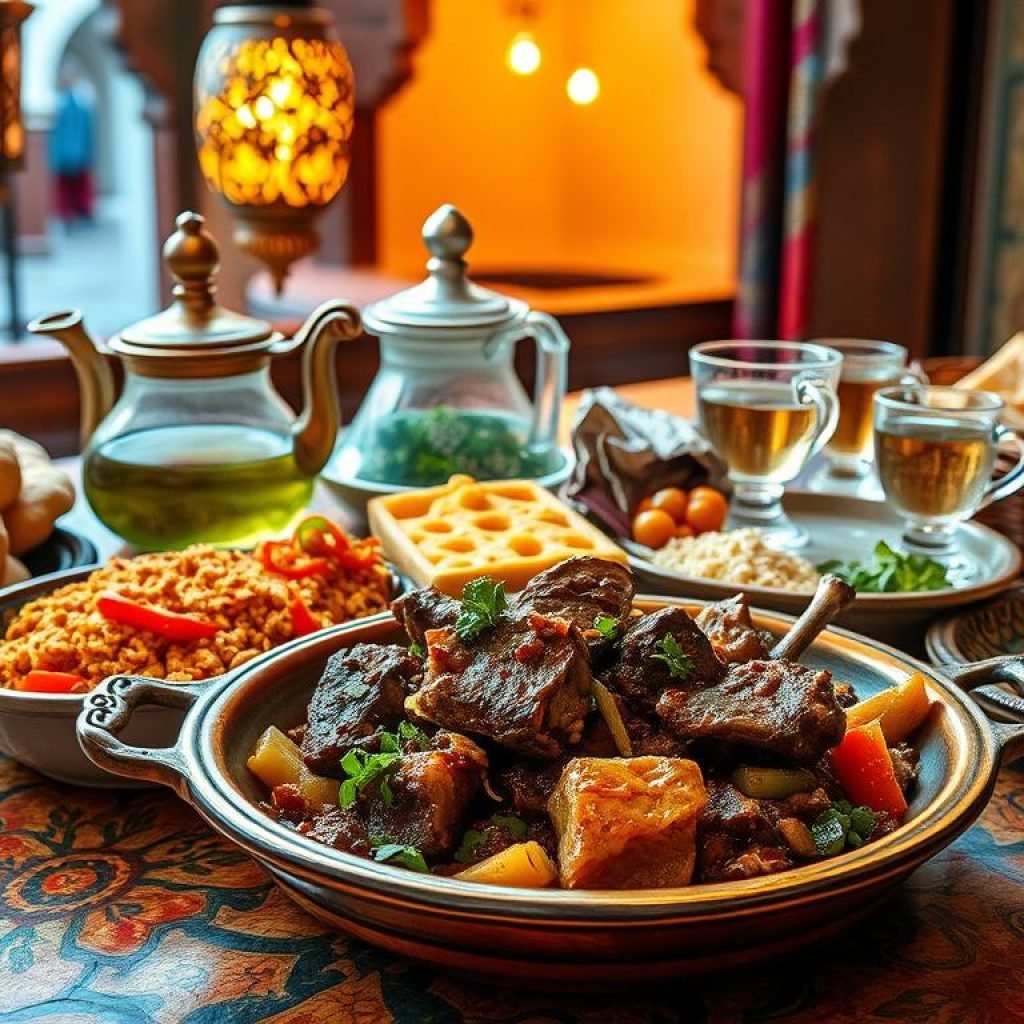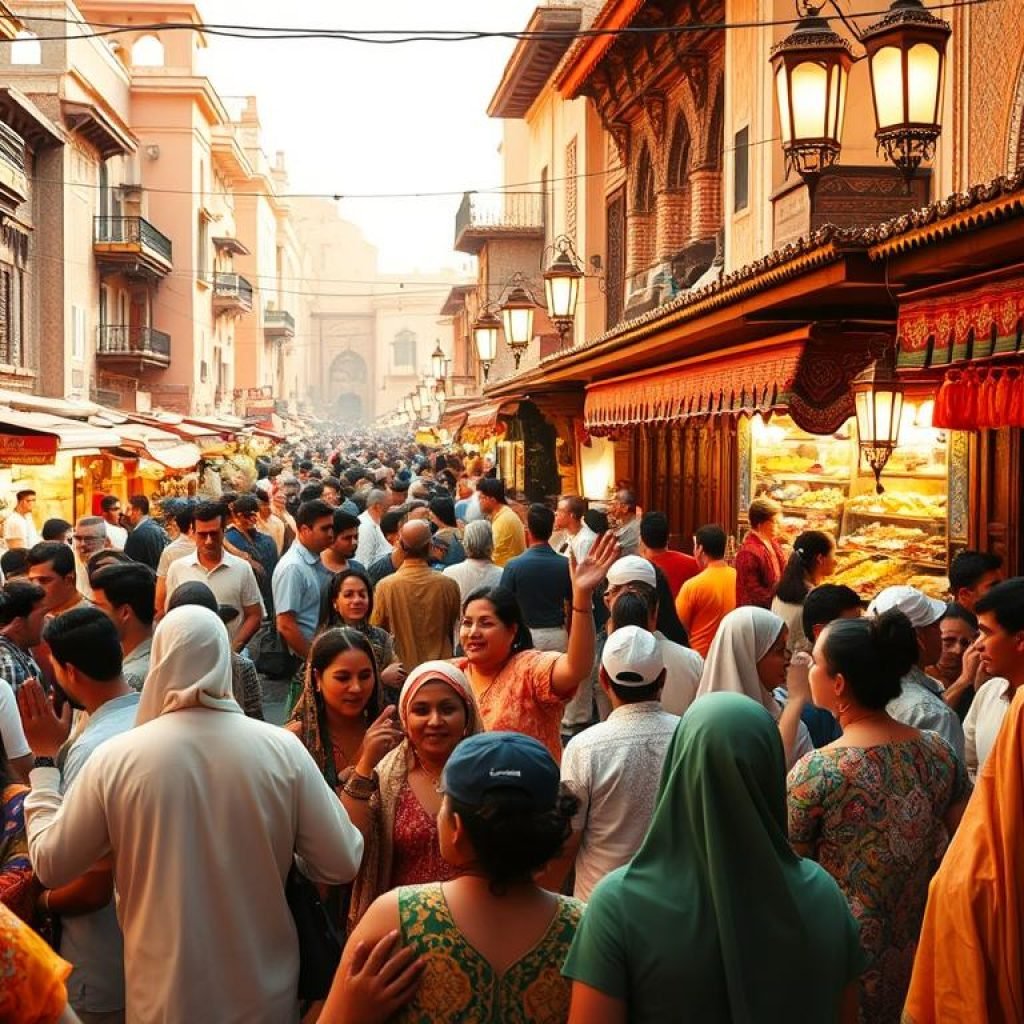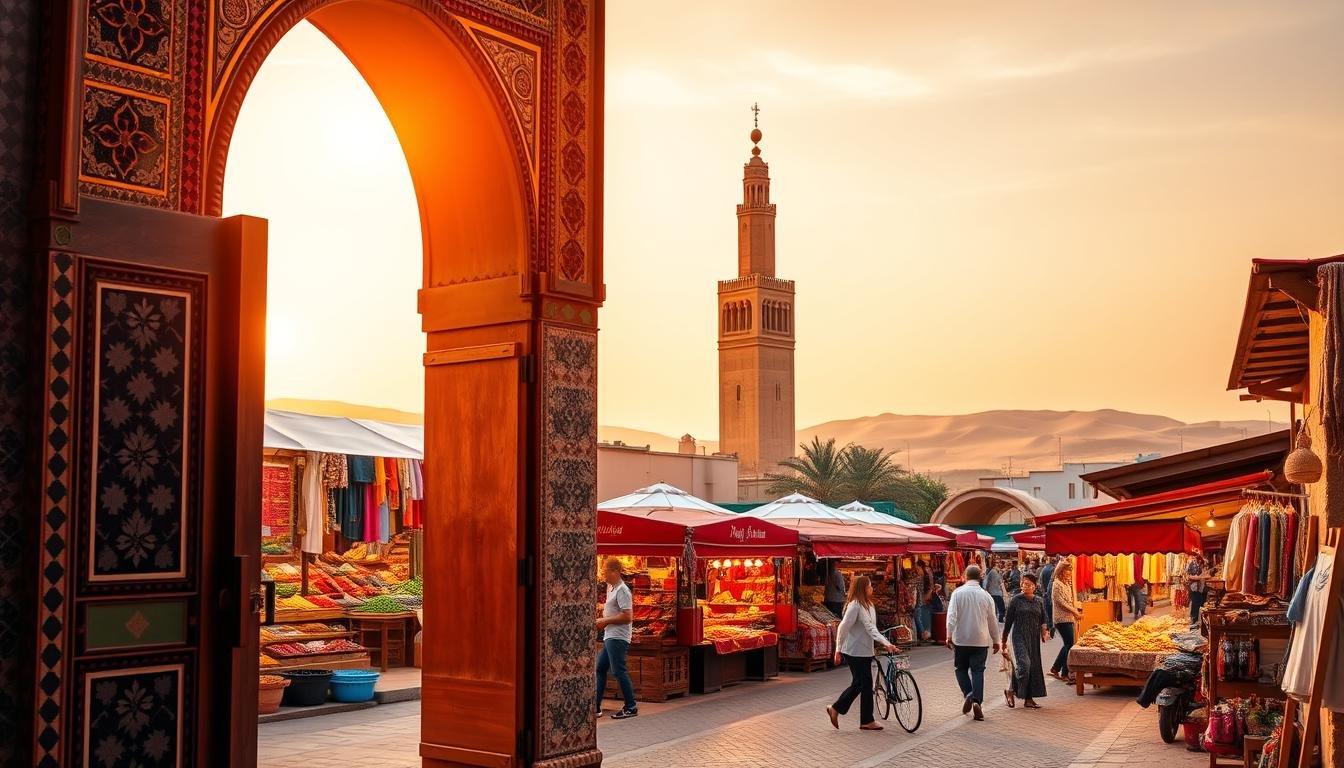What makes Moroccan culture so unique and captivating? Morocco blends African, Arab, and European influences. From Marrakech’s souks to Fez’s history, it’s full of fascinating facts. Explore Morocco’s rich traditions and history.
A Rich Cultural Heritage
Morocco sits at the crossroads of Europe, Africa, and the Middle East. This location has shaped its culture. The country boasts four imperial cities: Rabat, Marrakesh, Meknes, and Fes. Each city has its own history and charm.
Discover Moroccan culture through its architecture, cuisine, and markets. Learn about its traditions and more.
Key Takeaways
- Morocco has a rich cultural heritage influenced by African, Arab, and European traditions.
- The country is home to four unique imperial cities: Rabat, Marrakesh, Meknes, and Fes.
- Moroccan culture is known for its stunning architecture, delicious cuisine, and vibrant markets.
- The University of Al Quaraouiyine in Fes is recognized as the oldest continuously operating university in the world.
- Morocco’s film industry has gained international interest, with Ouarzazate known as “Ouallywood.”
- Moroccan culture facts and traditions are a fascinating topic to explore and learn more about.
A Rich Cultural Heritage
Morocco’s culture is a mix of Berber, Arab, and French. Its location at the crossroads of Europe, Africa, and the Middle East makes it a cultural melting pot. The Berber culture, or Amazigh, is especially important in Morocco’s history and identity.
The Arab conquest in the 7th century brought Islam and Arabic. French colonization in the 20th century also influenced architecture and education. Today, Morocco blends traditional and modern cultures beautifully.
- Language: Arabic and Berber are the two main languages spoken in Morocco, with French widely spoken and Spanish and English also used.
- Music and dance: Traditional Moroccan music features various genres, including chaâbi and aita, while dance is an integral part of Moroccan culture, with the belly dance being a popular form of expression.
- Cuisine: Moroccan cuisine is known for its rich flavors and aromas, with popular dishes like couscous, tagine, and pastilla.
In terms of population, Morocco is diverse, with Berber, Arab, and mixed Arab-Berber people. Most people follow Islam. Morocco’s cultural heritage shows its history and identity. Knowing about Morocco’s culture helps us understand its history and people.
Traditional Moroccan Cuisine
Moroccan cuisine is a mix of Arabic, Berber, Mediterranean, Andalusian, and European flavors. This blend makes it unique and delicious. Popular dishes like tagine and couscous are key to the Moroccan diet. Tagine, a slow-cooked stew, combines meat, vegetables, and dried fruits for a tasty and healthy meal.
Fresh ingredients are a big part of Moroccan cooking. The country grows many crops, including oranges, melons, tomatoes, and figs. Seafood is also important, with sardines and mackerel being favorites. Moroccan dishes often use spices, with ras el hanout being a special mix of 27 spices.
Some popular Moroccan dishes include:
- Chicken Tajine with Almonds and Prunes
- Lamb Tajine with Quince and Candied Walnuts
- Kefta with Baked Egg
- Charmoula Sardines
- Pastilla

Moroccan cuisine has a long history, starting in the 7th century BC. It has been shaped by Arabs, Berbers, and French cultures. Today, it combines old and new flavors, focusing on fresh ingredients and spices. Whether you try traditional dishes or seafood, Moroccan cuisine has something for everyone.
The Vibrant Moroccan Souks
Exploring Morocco means diving into the lively souks, a key part of Moroccan life. These markets are a feast for the senses. You’ll find colorful stalls, Moroccan music, and amazing smells. From Marrakech’s busy souks to Fez’s calmer ones, you’ll get a taste of Moroccan culture.
In the souks, you can find local crafts like textiles, jewelry, and spices. These items are big in Moroccan traditions. You can also try traditional foods like tagine and couscous, all while listening to Moroccan tunes. The souks draw many tourists, eager to see their vibrant colors and sounds.
- Exploring the narrow alleys and discovering hidden gems
- Haggling with vendors over prices
- Sampling local delicacies and drinks
- Watching traditional crafts being made
Visiting the souks lets you dive deep into Moroccan traditions and culture. It’s a key spot for anyone visiting Morocco.
Moroccan Festivals and Celebrations
Morocco is famous for its lively festivals and celebrations. These events show off the country’s rich cultural heritage. From the Rose Festival in Kelaat M’Gouna to the Gnawa World Music Festival in Essaouira, many events highlight Morocco’s diverse traditions and artistic expressions. This includes Moroccan art and architecture.
Some of the notable festivals in Morocco include:
- The Festival Fantasia, which features local riders performing synchronized horse charges
- The Erfoud Date Festival, which celebrates the date harvest in the region
- The Asilah Arts Festival, which transforms the coastal town into a canvas for artists from around the globe
These festivals not only show Morocco’s cultural diversity but also help the country’s economy and tourism. The Gnawa World Music Festival, for example, draws thousands to Essaouira each year. The Rose Festival in El Kelaa M’Gouna celebrates the rose harvest, boosting the local economy. The unique blend of Moroccan art and architecture is seen in the festival venues and events.

Moroccan festivals and celebrations are key to the country’s cultural identity. They offer a unique look into Morocco’s rich heritage and traditions. This includes its stunning Moroccan architecture and vibrant Moroccan art.
The Arabic and Amazigh Languages
North African culture is rich and diverse, with Morocco being a prime example. The country’s linguistic landscape is characterized by the coexistence of Arabic and Amazigh languages. Arabic, the official language of Morocco, is spoken by the majority of the population, while Amazigh, spoken by the indigenous Berber population, is also an important language.
The Amazigh language has a long history, with approximately 2000 years of presence in Morocco. It was constitutionally recognized as an official language in 2011, highlighting the importance of preserving North African culture. There are three main dialects of Amazigh in Morocco: Tashelhit, Tamazight, and Tarifit, with around 7.5 million Amazigh speakers recorded in the country.
The significance of the Amazigh language in Moroccan culture cannot be overstated. It is a vital part of the country’s identity, with approximately 40% of the population speaking Amazigh. The language incorporates all sounds found in Arabic, with additional sounds unique to Tamazight. The Tifinagh alphabet used for the Amazigh language consists of 33 letters, further emphasizing its distinctiveness.
In the context of North African culture, the Moroccan language plays a crucial role in shaping the country’s heritage. The language is a reflection of the country’s history, with influences from various cultures, including Berber, Arab, and French. The importance of multilingualism in Morocco is evident, with many Moroccans speaking multiple languages, including Arabic, Amazigh, and French.
Rug Weaving: A Time-Honored Tradition
Moroccan traditions are rich in craftsmanship, especially in rug weaving. This ancient craft has been passed down through generations. Many families keep their skills and techniques alive. Moroccan handicrafts, like rug weaving, are known for their beauty and quality.
The process of making a Moroccan rug is hard and takes a lot of time. Some rugs take months or even years to finish. The main material used is high-quality wool, often sourced locally and hand-processed.
The Art of Moroccan Carpets
Moroccan carpets are famous for their unique patterns and designs. These designs often symbolize protection, fertility, and balance. The rugs can fit well with many décor styles, from bohemian to minimalist.
Artisans often learn from family members, starting as children. This shows the tradition passed down through generations.
Some notable features of Moroccan rugs include:
- Earthy, neutral tones from natural dyes
- Vibrant colors in styles like Azilal and Boucherouite rugs
- Common patterns such as diamonds, zigzags, and crosses
- Regional variations in rug styles, influenced by Morocco’s diverse landscapes
Moroccan rugs have many uses, like insulation, ceremonial items, and decorative pieces. The use of natural materials and traditional techniques makes them sustainable. This makes them a valuable part of Moroccan traditions and handicrafts.
Moroccan Architecture: A Blend of Styles
Moroccan architecture is a mix of Islamic, Arab, and European styles. Morocco’s location at the crossroads of Africa, Europe, and the Middle East has made it a cultural and architectural melting pot. Over time, Moroccan architecture has evolved, blending these influences into a unique style.
The riads and kasbahs of Morocco stand out. They feature intricate tile work, ornate decorations, and beautiful gardens. These buildings show Morocco’s rich cultural heritage and its ability to merge different styles into something beautiful.
Moroccan architecture is known for zellij (mosaic tile work) and European-style doors and windows. These elements were introduced by different dynasties and colonial periods. This blend of styles makes Moroccan architecture fascinating.
Today, Morocco is also known for its modern architecture. Projects like the National Library of Morocco and the High-Speed Train Station in Kenitra showcase contemporary design.
Some notable examples of Moroccan architecture include:
- The Hassan II Mosque in Casablanca, one of the largest mosques in the world
- The El Bahia Palace in Marrakesh, which exemplifies stunning Alaoutie designs
- The ksar of Ait Benhaddou, a UNESCO World Heritage site and one of the most famous examples of traditional Moroccan architecture
Music and Dance in Morocco
Moroccan music and dance are key parts of the country’s rich culture. The music shows the country’s diversity, with each area having its own sound. You’ll hear everything from Chaabi music’s lively beats to Gnawa music’s heartfelt tunes.
Traditional dances in Morocco are just as captivating. Women perform the Shikhat dance, also known as Moroccan belly dance, at special events. Other dances, like Ahidous and Gnawa, are important to the Berber people and have UNESCO recognition.
Festivals like the Festival of Sacred Music of Fez highlight Moroccan music and dance. These events celebrate Moroccan culture and help keep traditional music and dance alive.
Some key traditional music and dance styles in Morocco include:
- Ahidous dance
- Gnawa dance
- Shikhat dance
- Chaabi music
- Gnawa music
These styles are vital to Moroccan culture. Efforts are underway to keep them alive for future generations.
The Significance of Hospitality in Moroccan Society
Moroccan hospitality is a key part of the country’s culture. Visitors are greeted with warm welcomes and generous gestures. This shows how much Moroccans value their guests, seeing them as a blessing from God.
Hosting guests is a source of pride for Moroccans. They go out of their way to make sure visitors are comfortable and happy. This is a big part of their customs.
The traditional Moroccan tea ceremony is a big part of this hospitality. It involves serving sweet mint tea, which is a big deal in Moroccan culture. The host pours the tea from high up, creating a creamy foam. This is a sign of welcome, respect, and generosity.
- Respect for guests, who are considered a blessing from God
- Generous offerings of food and drink, including traditional Moroccan tea
- A strong emphasis on social interaction and community bonding
These values are at the heart of Moroccan customs. They make the country’s social fabric strong. By embracing these values, visitors can truly experience Moroccan hospitality. They can also make lasting connections with the people they meet.
Clothing and Fashion Trends
Moroccan fashion is a mix of old and new styles. It shows the country’s deep cultural roots. Traditional clothes like the djellaba and kaftan are made from wool and cotton. They’re worn for big events like weddings and religious festivals.
Today, Moroccan fashion adds a twist to old designs. Designers use natural materials like silk, cotton, and wool. This makes clothes comfortable and breathable. The colors used, like indigo, saffron, and turquoise, are bright and carry special meanings.
- Traditional garments like the djellaba and kaftan
- Use of natural materials, such as silk, cotton, and wool
- Vibrant colors and intricate patterns
- Incorporation of traditional motifs and designs
Moroccan fashion is a blend of old and new. It shows the country’s rich culture and people’s love for beauty. With its focus on natural materials, bright colors, and detailed patterns, Moroccan clothes truly represent the country’s fashion traditions.
The Impact of Religion on Daily Life
At the heart of Moroccan culture is Islam’s deep influence. Over 99% of people are Sunni Muslim. This makes Islam the main religion in Morocco. The five daily prayers and Ramadan are big parts of many Moroccans’ lives. Exploring this religious aspect of Moroccan culture helps visitors understand its rich heritage.
The government lets 44 registered foreign-resident Christian churches operate. But, it bans public worship for groups not registered. The law also punishes anyone who attacks Islam, with jail time from six months to five years. This shows how important Islam is in Moroccan life and the need to respect its customs.




Comment (0)